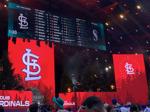From their season-opening series in Los Angeles through much of this season’s unofficial first half, the Cardinals dipped, ducked and dodged a clear fifth-starter conundrum.
It wasn’t always pretty. In fact, it often was pretty ugly.
The past month and change has clouded that picture — in a more positive fashion.
Here’s a question to answer honestly as the fast approaching All-Star break invites amplified trade-deadline debate: Do you feel better about the Cardinals’ rotation today than you did when the season started?
It’s hard not to, right?
Most of it has to do with how the rotation’s four veterans, all new free-agent additions this offseason, have made a collective habit of giving the team a chance to win, or better.
People are also reading…
And lately, a lot of it has to do with Andre Pallante, who despite getting the last crack at the fifth-starter job has provided the most impressive performance there yet.

Cardinals pitcher Andre Pallante throws in the third inning against the Kansas City Royals on Tuesday, July 10, 2024, at Busch Stadium in ºüÀêÊÓƵ.
Adding a starter to this group before the July 30 trade deadline used to seem so obvious it was confusing why the Cardinals weren’t trying to jump out in front of others to do so first. Now, the Cardinals can be glad they waited, whether they decide to add or not. If nothing else, they are less desperate. They can be more selective.
Once Sonny Gray returned from a hamstring scare to make his briefly delayed Cardinals debut, the rotation’s four veterans have remained healthy while churning out the kind of starts they were brought here to provide. Their ability to hold up was questioned. They still have another half to go. But so far, they have been getting the job done more times than not.
Example: Lance Lynn, soaked in sweat from the moment he chucked his first fastball Saturday afternoon, coughed up a no-doubt home run to Seiya Suzuki in the first inning — gulp — but then proceeded to swallow six innings, allowing only one more run in what became a Cardinals romp.
Important win. It kept the Cardinals from their first four-game losing streak since their Mother’s Day glow-up. It also made the Cardinals 11-8 when Lynn starts. And it was Lynn’s third quality start in his last four tries, something perhaps overshadowed by his 11-run disaster in Washington his previous time out.
Zoom out from that exact moment between doubleheader games Saturday, and the Cardinals were 40-32 when one of their four veteran anchors takes the mound.
Meanwhile the Cardinals were 9-13 when a starter not named Gray, Mikolas, Gibson or Lynn gets the ball. That’s how bad the fifth-starter issue dinged the Cardinals throughout this first half. Here’s some more on that topic.
Lynn’s start Saturday gave the Cardinals 36 quality starts, meaning a starter lasted six or more innings while surrendering three or fewer earned runs. The 35th had come from Gray in Friday’s loss to the Cubs, one of just two times the Cardinals wasted a quality start from Gray. Here’s how many quality starts the fifth-starter pool has combined to produce: three. And here’s how many times the fifth-starter pool produced starts that didn’t finish five innings: 10 times in 22 tries.
Is Pallante the fifth-starter cure? Could be. It would be nice to see even more proof before trade-deadline decisions must be finalized.
But Pallante does have a 3.70 ERA as a starter through eight tries since he returned from Class-AAA Memphis as a repurposed reliever.
He’s held opponents to a .692 on-base plus slugging percentage, which is lower than every veteran Cardinals starter but Gray’s.
And since Pallante rejoined the Cardinals rotation on May 29 after his time lost in the bullpen wilderness, he has the highest groundball rate (57.6%) and the lowest ERA (3.70) of any Cardinals starter who has made five or more starts.
Two things can be true at once.
The Cardinals caused themselves a considerable amount of stress by once again trusting Steven Matz to hold a rotation spot and the chaotic search for stability that followed after he was injured again.
The Cardinals also appear set to enter the All-Star break in a better spot rotation-wise than how they entered the season.
Their rotation is as stable as it has been, and they are in a wild-card spot with a second-half invitation to go win their division.
They can still add a starting pitcher. And they still probably should. But what the rotation could really use most seems to have changed, from a serviceable arm to one that elevates the entire group.
And those tend to be the most costly arms to acquire.















